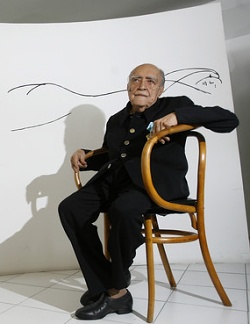
Niemeyer paid tribute to the curves of Brazilian women with his buildings
 |
"Some buildings were realized in that speed almost without a project, a lot of things were imagined only during their execution," Niemeyer recalled about the project initiated by Brazilian President Juscelino Kubitschek, who had Czech ancestors. The floor plan of Brasília, shaped like an airplane, was conceived by Lucio Costa, with whom Niemeyer gained his first architectural experience in the 1930s. Niemeyer designed most of the buildings in the city that rose in the middle of an inhospitable wasteland at an altitude of about a thousand meters.
"Concrete and glass, columns and arches, long access ramps, or wide staircases, flat roofs" - thus Niemeyer formulated the look of the buildings from the first phase of Brasília's construction (up to 1960). A highlight among them is the almost entirely glass cathedral, resembling a volcano, a flower, or a thorny crown on Jesus's head. In 1987, Brasília was inscribed on the UNESCO World Heritage List.
Niemeyer, however, lived in the old metropolis of Rio de Janeiro, near which, in Niterói, stands another of his original works - the Contemporary Art Museum. This building on a cliff above the sea, resembling a UFO and often ranked among the top ten buildings of the 1990s, illustrates Niemeyer’s belief that "the most important thing in architecture is the moment of shock." Therefore, some criticize him for excessive intoxication with the appearance of objects and little interest in their functionality.
Oscar Ribeiro de Almeida Niemeyer was born on December 15, 1907, in Rio de Janeiro, where he attended the School of Fine Arts from 1930 to 1934. He then joined the studio of Lucio Costa, the then-leading figure in Brazilian architecture, where he worked on many prestigious projects - for example, the Ministry of Education and Health building in Rio de Janeiro or the pavilion for the world's fair in New York.
Originally, Niemeyer was strongly influenced by Le Corbusier, with whom he closely collaborated on the design of the new UN headquarters in New York right after the war. He also counted among his favorite and inspiring architects, especially Mies van der Rohe and the Catalan Antoni Gaudí, with whom he shared a fascination for graceful curves and an intolerance of right angles.
Just as he hated sharp edges and straight lines, Niemeyer also detested capitalism: "We must change this regime of violence, power, and wars." "I think Bush is an idiot. A thief like any other, who threatens the whole world and South America," Niemeyer asserted, who joined the Communist Party right after the war and claimed that revolution was the best solution.
Due to his leftist beliefs, Niemeyer had to emigrate from Brazil after the coup in 1964. He lived mainly in Paris until 1975, where he designed, for example, the headquarters of the French Communist Party and the administrative building of Renault. From this period also comes his project for the building of the Mondadori publishing house, which many considered unfeasible at the time. The five floors of this Milan building seem to hang from the ceiling, and the columns are irregularly spaced along the facade.
Niemeyer’s works (he is the author of over 600 works) can be seen around the world - for example, in Algiers he designed a university, in Madeira a casino, and in the Malaysian Penang the state mosque. In 1988, he was awarded the Pritzker Prize, the equivalent of the Nobel Prize in architecture. One of his last projects, a complex of administrative buildings in Belo Horizonte, the capital of the state of Minas Gerais, was ceremoniously opened in the spring of 2010.
"The best thing is to have a woman by your side - and then let God’s will be done," asserted the architect, who remarried at the age of 98 to his sixty-year-old secretary and who almost until his death went to his studio to work almost every day. He married his first wife, who died in 2004, when he was twenty-one and had a daughter with her. Recently, Niemeyer also devoted himself to music, composing lyrics and part of the music for samba.
The English translation is powered by AI tool. Switch to Czech to view the original text source.
0 comments
add comment










